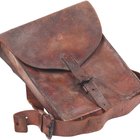
Jupiterimages/Goodshoot/Getty Images
A clutch purse accessorizes formal or semi-formal attire when a large handbag or shoulder bag is out of place or cumbersome. Make your own leather clutch or rejuvenate an old clutch with a new lining. Insert a drop-in lining in your clasp-top or zippered clutch. Line individual pieces for your envelope-style purse. If you like organizers, sew pockets and zippered slots into the lining before purse construction.
Envelope-Style Clutch
Cut lining fabric using the same pattern pieces used to cut leather pieces for your clutch purse.
Sew pockets into the lining if desired. Make a patch pocket for a cell phone, compact or lipstick using a square or rectangle of the lining fabric. Cut the patch large enough to accommodate the item to be stowed inside, plus a seam allowance. Turn under the seam allowance on the sides and bottom of the patch. Hem the top of the patch. Top stitch the patch to the right side of the lining.
Place the right sides of the leather and lining together. Stitch three sides of the fabric together, beginning stitches approximately 1 1/2 inches from the corner on the side that will be left open. Back stitch a few stitches to prevent raveling. Use a 3/4-inch seam allowance, or follow the pattern instructions. When the third side is stitched, turn the corner and sew approximately 1 1/2 inches past the corner. Back stitch to lock the stitches.
Trim the seam allowance to 1/4 inch. Clip the corners close to the stitching to eliminate unnecessary bulk. Turn the fabric right side out, pulling the lined leather through the opening left on one side. Push each corner out fully. Finger press the seam allowance of the opening.
Top stitch around the lined leather on all four sides. Complete the purse construction according to the pattern directions.
Drop-in Lining
Cut the fabric lining using the same pattern pieces used to cut out the leather pieces for your clutch.
Sew pockets into the lining before construction of the purse, if desired.
Place right sides of the lining fabric together and sew, using a 3/4-inch seam allowance or according to pattern instructions. In the bottom seam, leave an opening large enough to pull the bag through. Trim the seam allowance to 1/4 inch. Finger press the opening seam allowance.
Drop the leather pouch, right side out, into the lining pouch. Sew the top edge of the pouch with right sides together. Trim the seam allowance to 1/4 inch. Pull the leather pouch through the opening in the lining pouch. Slip stitch the opening closed. Push the lining inside the bag.
Attach clasp frame according to manufacturer's instructions.
Replace Lining
Rejuvenate an old leather clutch by replacing the drop-in lining. Using a seam ripper, take out the stitches where the lining is attached to the facing band.
Examine the old lining carefully before taking it apart to make a pattern for the new lining. Using a seam ripper, take the old lining apart.
Cut lining fabric pieces using the old lining pieces as a pattern. Leave a seam allowance of 3/4 inches.
Add pockets to the new lining, if desired. Sew the lining pieces together, leaving an opening in the bottom seam so the leather pouch can be pulled through. Trim the seam allowance to 1/4 inch.
Drop the leather pouch inside the lining, placing the right sides together. Sew the lining to the facing. Pull the leather pouch through the opening in the bottom of the lining. Finger press the seam allowance in the opening and slip stitch the opening together. Push the lining inside the leather clutch.
Related Articles

How to Make an Inside Pocket for a ...

How to Put a Zipper on a Jacket

How to Repair Cigarette Burns in Leather

How to Make Mens Moccasin Boots

How to Make a Satchel

How to Make Faux Leather Jackets Last ...

How to Repair a Torn Lambskin Leather ...

How to Glue a Leather Shoe Strap

How to Fix Leather Boots

How to Fix Ripped Leather Gloves

How to Restore a Crocodile Purse

How to Soften Leather Jackets

How to Sew a Kippah

How to Repair Leather Straps

How to Alter the Length of a Leather ...

How to Make a Bridal Money Bag

How to Care for and Clean Vintage ...

How to Prevent a Designer Purse From ...

How to Make an Inside Pocket for a ...

How to Fix Cuts in Polyester Clothes
References
Writer Bio
For Judy Kilpatrick, gardening is the best mental health therapy of all. Combining her interests in both of these fields, Kilpatrick is a professional flower grower and a practicing, licensed mental health therapist. A graduate of East Carolina University, Kilpatrick writes for national and regional publications.
Photo Credits
Jupiterimages/Goodshoot/Getty Images